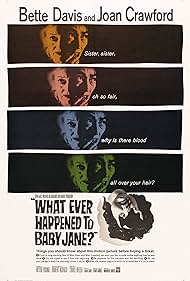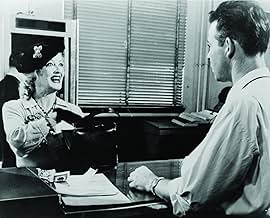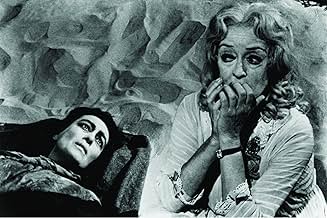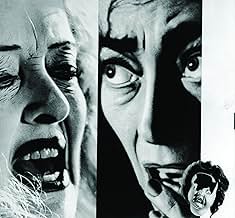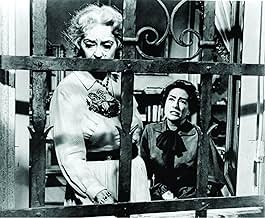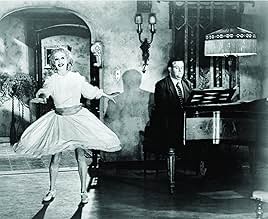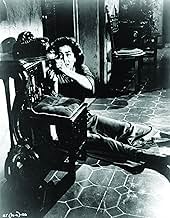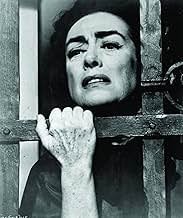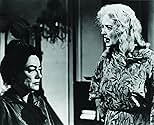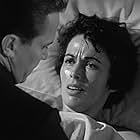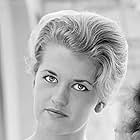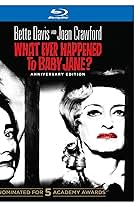A former vaudeville child star torments her paraplegic sister, who eclipsed her as a movie star, in their decaying Hollywood mansion while desperately clinging to hopes of a comeback.A former vaudeville child star torments her paraplegic sister, who eclipsed her as a movie star, in their decaying Hollywood mansion while desperately clinging to hopes of a comeback.A former vaudeville child star torments her paraplegic sister, who eclipsed her as a movie star, in their decaying Hollywood mansion while desperately clinging to hopes of a comeback.
- Won 1 Oscar
- 5 wins & 11 nominations total
- Cora Hudson
- (as Ann Barton)
- Liza Bates
- (as B.D. Merrill)
- Director
- Writers
- All cast & crew
- Production, box office & more at IMDbPro
Featured reviews
As a writer/producer who lived and worked in Hollywood for 30 years, I submit that those comments represent a "denial syndrome" of people who are ignorant of the facts of Hollywood.
What is so "horrifying" about WEHTBJ? is that the film is an utterly realistic psychodrama about two specific sisters of that era.
It's easy to say that Bette Davis' performance/makeup was "over the top," except that they weren't. In fact, I thought her look was taken from a sad "street person" in Hollywood who, in her seventies, walked up and down Hollywood Boulevard in a pink ball-gown and dead blonde wig and thick makeup, speaking into a transistor radio she held to her ear -- in the 60s, long before cell phones -- "talking" to the FBI about people chasing her.
Perhaps those who've spent their lives elsewhere, other than in Hollywood, feel that the characters in WEHTBJ? are "over the top." But they're not.
That's what makes them so heartbreaking. And the incredibly brave performances by Joan Crawford, Bette Davis, Victor Bono and the rest -- not to mention the script and Robert Aldrich's direction -- make this simply the most definitive "Hollywood" psycho-thriller since "Sunset Boulevard."
There's "A Star Is Born," in any of its incarnations. Which is also "true" in its (their) way.
And there is "Sunset Boulevard" and "Baby Jane," which are even more true, and more brilliantly made.
These are not "horror films." They are riveting psychological studies, cast with astonishing actors, and magnificently directed and photographed.
They are the equivalent of Hitchcock's "Psycho," IMHO, which was preceeded by "Sunset Boulevard" and followed by "Baby Jane."
Each different, each brilliant, each marked by some of the most indelible performances ever captured on film.
It's typical of adolescents to make a "joke" about things that make them uncomfortable.
But when experience and age acquaint one with people like Baby Jane and Norma Desmond and, yes, Norman Bates, what's the point of joking?
These three films will tell those characters' stories forever, and better than 99% of films ever made.
That's why they're classics.
But the main credit of the picture is casting together to real big names in Hollywood's history, not at their peak then but always reliable and attractive to see. Bette Davis (Jane) takes the most interesting character as the former child star that couldn't make it as an adult in show business so she has gone insane and keeps behaving as the spoiled child he was. She looks grotesque and ridiculous in her child outfits, hairdo and heavy make up. Davis is outstanding in her role and looks really mean when she tortures both mentally and physically her sister Blanche, delicate and reasonable. Joan Crawford plays Blanche and very well too, a former big star whose career ended after a strange car accident that put her on a wheel chair for life.
In the end things are not completely as they seem but the final twist is not what makes this film an extremely good one; it's the strange relationship between the sisters, that requires of that final twist to understand Blanche's tolerant conduct towards her sister.
The movie is perhaps a little too long and it would probably have been even better with a 10 minutes cut. But no doubt this is a top product in its genre and a great movie indeed.
A touch of Norma Desmond/Sunset Boulevard here--Bette as a delusional has-been who actually believes her career can be resurrected. Joan as the sister confined to a wheelchair as a result of a horrific car accident. In the drive-way. Supposedly run over by Baby Jane in the 1930s but never proven or prosecuted.
Fast forward to the 1960s, and Baby Jane takes it hard upon learning Blanche plans to sell their old stately mansion. She begins a systematic torture of Blanche that amounts to elder abuse in today's terms. Viewers who saw this film 60 years ago were frightened by the hair-raising dinner entrees given to Blanche: Her dead pet bird served up on a tray of tomatoes and the rat well-done. What doesn't hold up is Blanche's inability to bring attention to her imprisonment. For instance, her neighbor is outside below her window cutting flowers. Instead of screaming like a maniac for help, she writes a complicated note on a typewriter, balls it up, and throws it out the window. Of course, Baby Jane finds it. Duh. When the affected Victor Buono visits the house as a loony piano accompanist for Blanche, she could have screamed and yelled for help. She doesn't.
For all their competition, both Bette and Joan are good here and the ending is extremely ironic. Davis always claimed that Joan campaigned against her at Oscar time and that is why she didn't win. Davis certainly hadn't lost her willingness to look as unattractive as she needed to be in order to play the part. Overweight, dressed up like she is 10 not 55 with her hair in blonde curls and grotesque pancake makeup on, she is the ideal aged homicidal maniac of a Baby Jane doll. Joan's part requires much more subtlety to the point of not doing what she must to save herself. These two definitely make it a worthwhile watch.
Storyline
Did you know
- TriviaAccording to Bette Davis in her book "This N' That," the film was originally going to be shot in color. Davis opposed this, saying that it would just make a sad story look pretty.
- GoofsIn the 1935 time line (11 minutes into the film), Ben Golden (Bert Freed) and Marty McDonald (Wesley Addy) are walking past a row of buildings in the studio discussing Baby Jane's acting. There are window air conditioners in almost every upper floor window of the 2-story building behind them. But the first window air conditioner wasn't marketed until 1938, and it wasn't until 1947 that they were mass-produced.
- Quotes
Blanche: Jane, do you remember when I first came back after the accident?
Jane: You promised you wouldn't ever talk about that again.
Blanche: I know I did. But I'm still in this chair. After all those years, I'm still in this chair. Doesn't that give you some kind of responsibility? Jane, I'm just trying to explain to you how things really are. You wouldn't be able to do these awful things to me if I weren't still in this chair.
Jane: But you *are*, Blanche! You *are* in that chair!
- Alternate versionsThe original British release was cut in two places: in Reel Four, where Jane kicks Blanche only once instead of multiple times, and Reel Six, which eliminated some shots of Blanche tied up to the bed and writhing. Both cuts were mandated by the BBFC in order to receive an "X" certificate. Subsequent reissues restored the footage.
- ConnectionsEdited into The Time That Remains (2012)
- SoundtracksI've Written a Letter to Daddy
Music by Frank De Vol
Lyrics by Bob Merrill
Performed by Bette Davis
Also performed by Julie Allred (dubbed by Debbie Burton)
Details
- Release date
- Country of origin
- Official site
- Language
- Also known as
- ¿Qué pasó con Baby Jane?
- Filming locations
- Production company
- See more company credits at IMDbPro
Box office
- Budget
- $980,000 (estimated)
- Gross worldwide
- $4,451
- Runtime2 hours 14 minutes
- Color
- Aspect ratio
- 1.85 : 1
Contribute to this page

